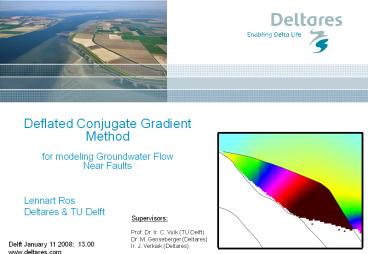Deflated Conjugate Gradient Method - PowerPoint PPT Presentation
Title:
Deflated Conjugate Gradient Method
Description:
... Conjugate Gradient Method. for modeling Groundwater Flow. Near Faults ... matrix is symmertic negative definite. Preconditioned Conjugate Gradient Method: ... – PowerPoint PPT presentation
Number of Views:305
Avg rating:3.0/5.0
Title: Deflated Conjugate Gradient Method
1
- Deflated Conjugate Gradient Method
- for modeling Groundwater Flow
- Near Faults
Lennart Ros Deltares TU Delft Delft
January 11 2008 13.00 www.deltares.com
Supervisors Prof. Dr. Ir. C. Vuik (TU
Delft) Dr. M. Genseberger (Deltares) Ir. J.
Verkaik (Deltares)
2
Outline
3
Outline
- Introduction
- Deltares
- Subsurface, Geohydrology Faults
- MODFLOW
- IBRAHYM problem
- Equation, Discretization Method
- Testcase Observations
- Deflation Techniques First Results
- Further Research Goals
4
Introduction
5
Introduction
Deltares
January 1st 2008
6
Introduction
Subsurface
- Subsurface is schematized in layers .
- Successive sand and clay
- (aquifers and aquitards)
- Assumption
- Horizontal flow in aquifer
- Vertical flow in aquitard
7
Introduction
Geohydrology
- Connected pores give a rock permeability.
- The driving force for groundwater flow is the
difference in height and pressure. - To represent this difference we introduce the
concept of hydraulic heads, h L.
8
Introduction
Faults
- Medium Faults are vertical barriers inside
aquifers. - Faults do not usually consist of a single, clean
- fracture ? fault zone.
- Different types of faults.
- Main property low permeability.
- Large contrasts in parameters.
9
Introduction
All Faults in the IBRAHYM model
10
Introduction
MODFLOW
- MODFLOW is a software package which calculates
hydraulic heads. - Developed by the U.S. Geological Survey.
- Open-source code everyone can use and improve
this program - Rectangular grid and uses cell-centered
variables. - Quasi-3D model.
11
Introduction
IBRAHYM
- groundwater model developed for several
waterboards in Limburg. - large variety of faults in subsoil.
- faults cause model to suffer from bad convergence
behavior of solver. - uses at most 19 layers to model groundwater flow
area. - uses grid cells of 25 times 25 meter to get
detailed information. - most famous fault is de Peelrandbreuk in
Limburg.
12
Equation, Discretization Method
13
Equation, Discretization Method
Governing Equation
hydraulic conductivities along x,y, and z coordinate axes LT-1,
h potentiometric head L,
W volumetric flux per unit volume representing sources and sinks of water T-1,
Ss specific storage of porous material L-1,
t Time T
Where
14
Equation, Discretization Method
Finite Volume Discretization
15
Equation, Discretization Method
Finite Volume Discretization
External Sources
Time Discretization
Euler Backwards
16
Equation, Discretization Method
Discretized Equation Using Finite Volume Method
Where
17
Equation, Discretization Method
Faults in MODFLOW
- When we model a fault in the subsoil we update
the hydraulic conductance.
18
Equation, Discretization Method
Solution Method
- MODFLOW use stress, time and inner iteration
loops - We look at inner iteration loop
- solves a linear system of equations
- matrix is symmertic negative definite
- Preconditioned Conjugate Gradient Method
- Incomplete Cholesky Decomposition
- also SOR
19
Testcase Observations
20
Testcase Observations
Simple Testcase
- 15 rows, 15 colums, 1 layer
- 1 fault on 1/3th of the domain
- Cells represent an area of
- 25 x 25 meters
21
Testcase Observations
Observations for simple testcase in Matlab
Preconditioning Incomplete Cholesky
22
Testcase Observations
Observations for simple testcase in Matlab
23
Testcase Observations
Observations for simple testcase in Matlab
Smallest eigenvalue 0.00010283296716 Next
eigenvalue 0.04870854847951
24
Testcase Observations
- Due to the small eigenvalue we have a
- slow converging model.
- Want to get rid of this eigenvalue
- IDEA USE DEFLATION
25
Deflation Techniques
26
Deflation Techniques
Basic Idea of Deflation
General linear system of equations
Define , where and assume
A to be SPD So and
27
Deflation Techniques
Basic Idea of Deflation
Note we can write But since we only need
to compute Since we solve the deflated
system
28
Deflation Techniques
Deflation using Eigenvectors
Assume that A has eigenvalues and we choose
the corresponding eigenvectors such
that If we now define Then
29
Deflation Techniques
Alternative Deflation Techniques
- Random Subdomain Deflation
- Deflation based on Physics
- Use faults as boundary of domain
- Define vectors such that an element next to a
- fault has value 1 and otherwise 0.
30
Deflation Techniques
Results for the test problem
- Deflation using subdomain deflation
- 1 domain left of fault
- 1 domain right of fault
- The eigenvector corresponding to the smallest
eigenvalue is in the span of these two vectors. - Eigenvalues of and are
almost the same, but the smallest is cancelled
now.
31
Deflation Techniques
Results for the test problem
- Less iterates are needed
- Result looks positive
32
Further Research
33
Further Research Goals
- Future Research
- How representive is the Matlab model?
- Can faults in IBRAHYM be seen as the sum of
local faults? - Is deflation always faster, even if we do not
have faults? - Future Goals
- Implementing deflation in MODFLOW.
- Choose suitable deflation vectors such that
- vectors are easy to construct,
- a priori information is used to construct
vectors, - choice of vectors is generetic and not problem
dependent. - Reduce number of iterations in PCG solver and
gain wall-clock times.































